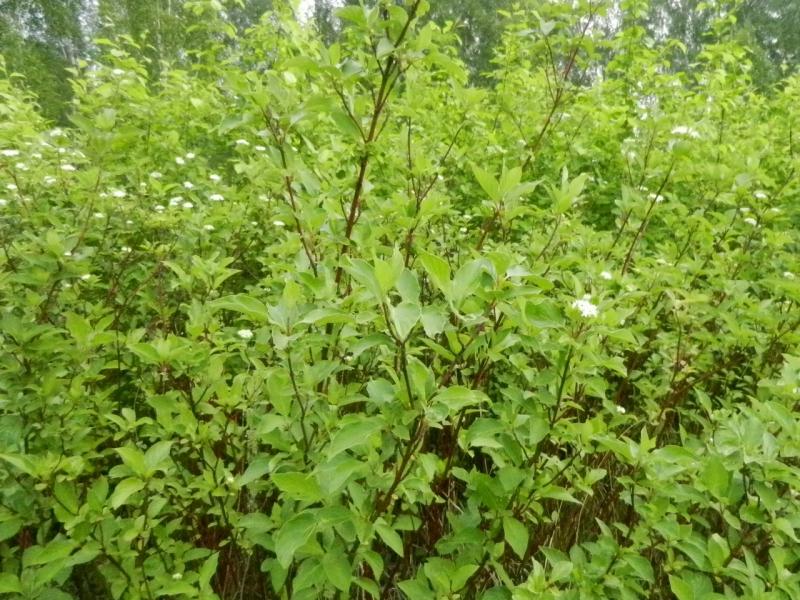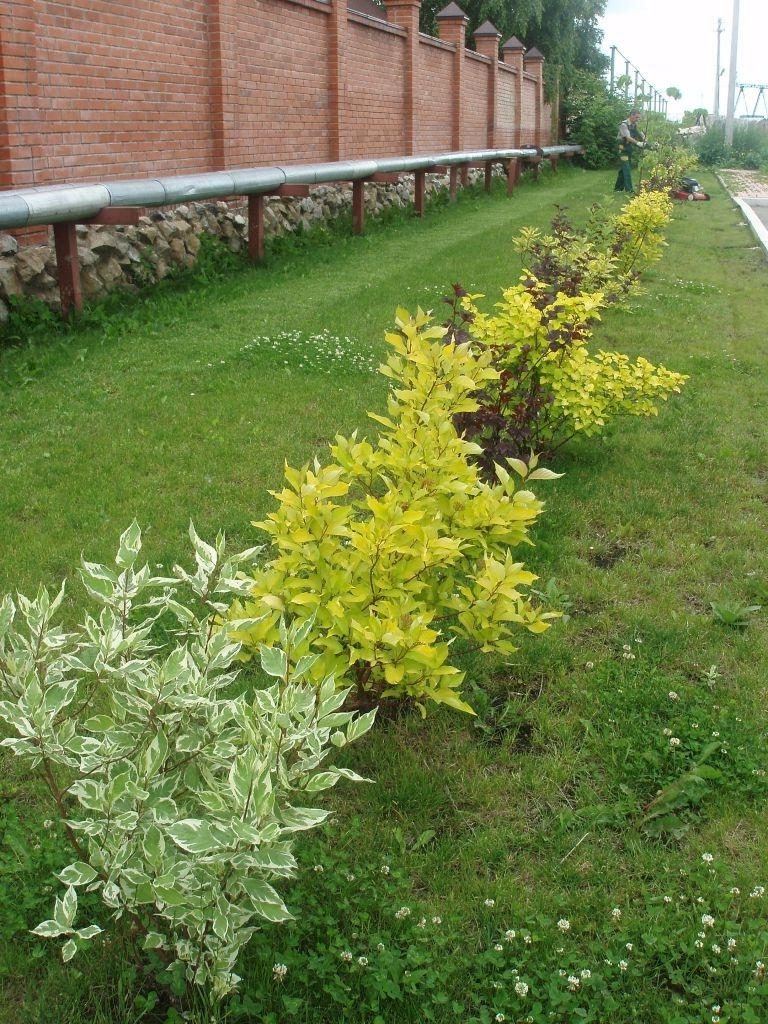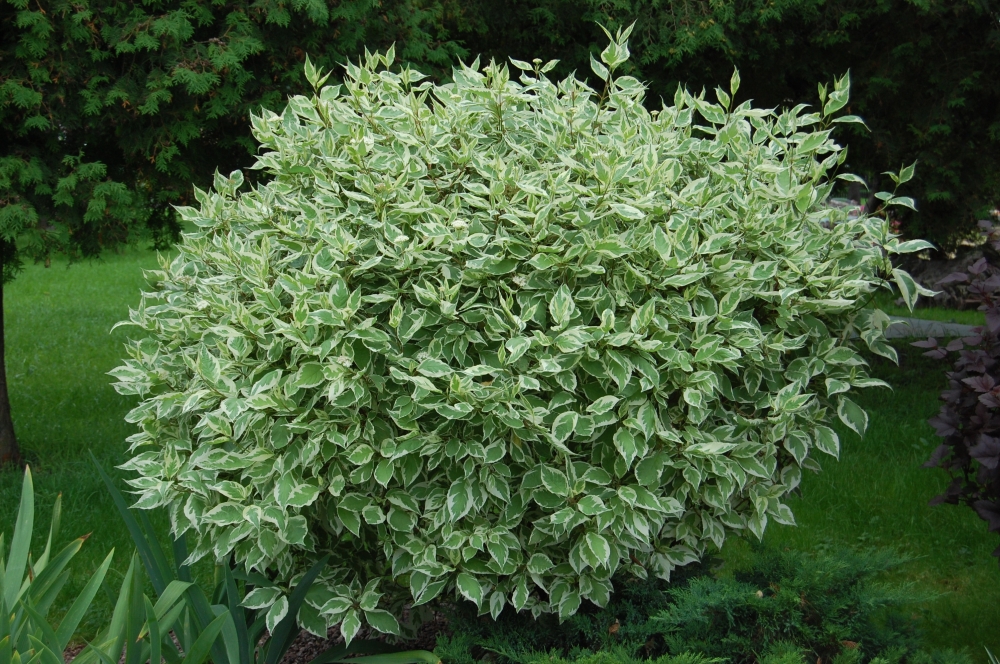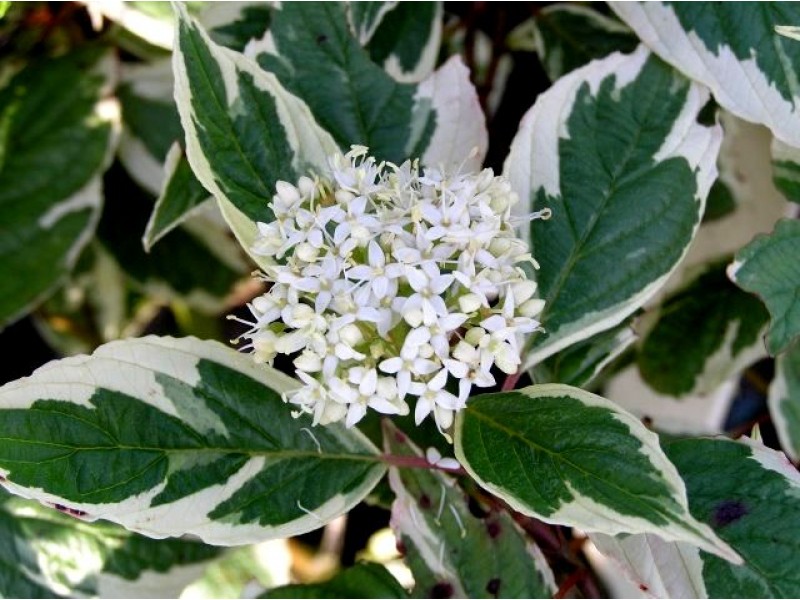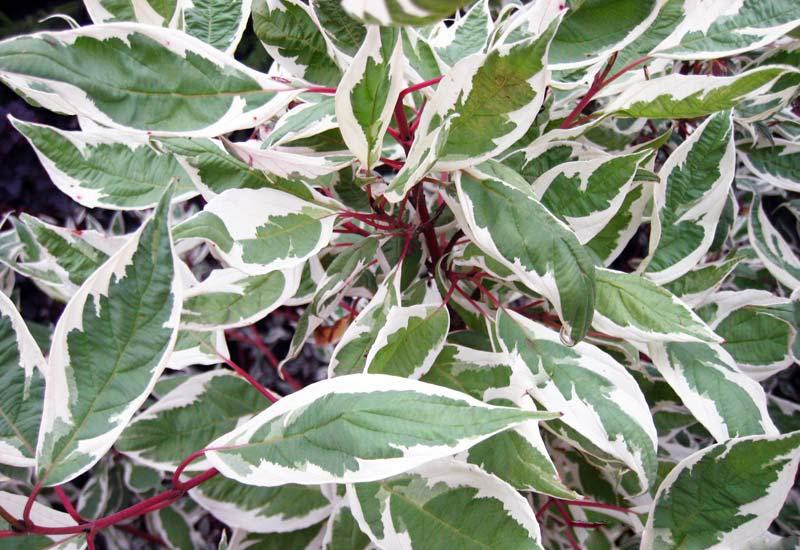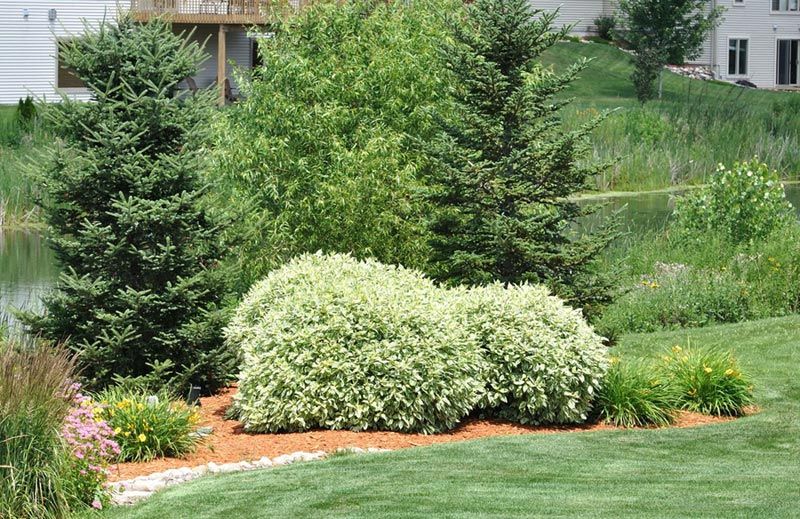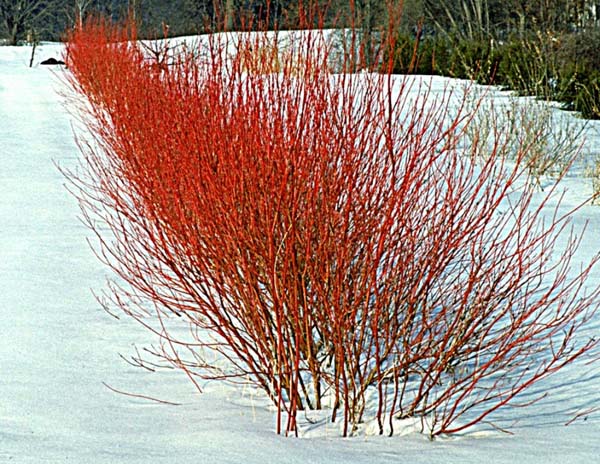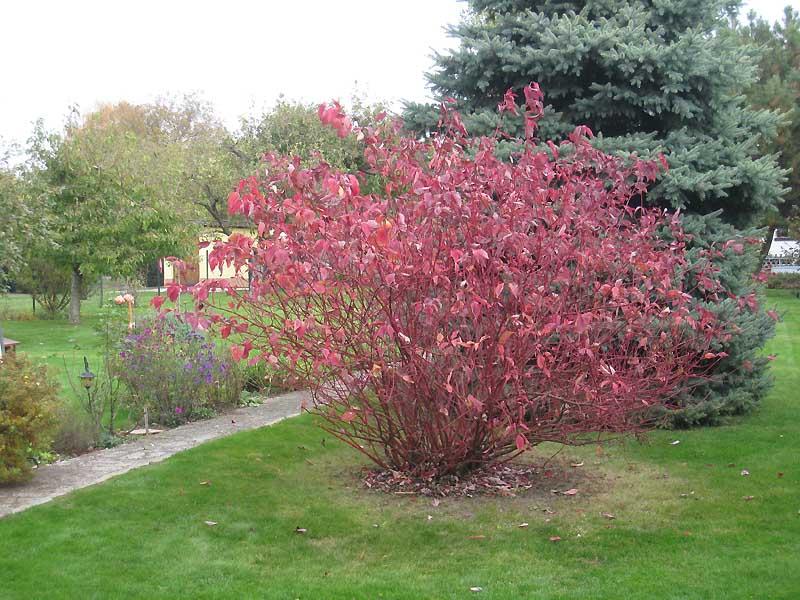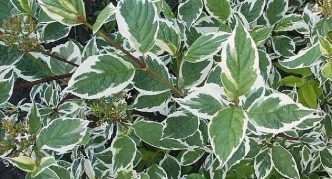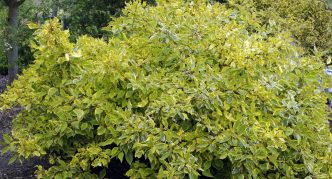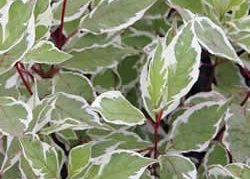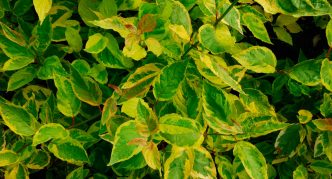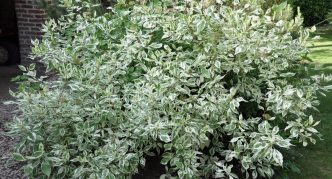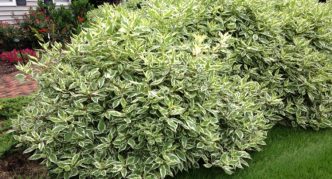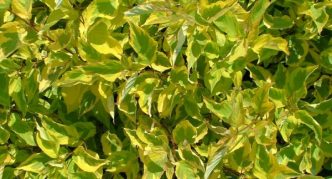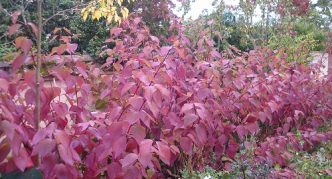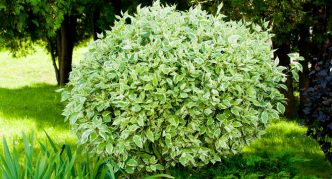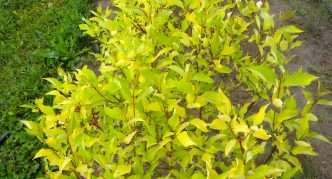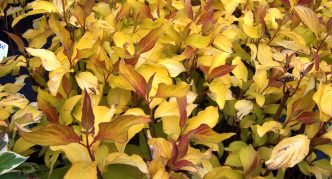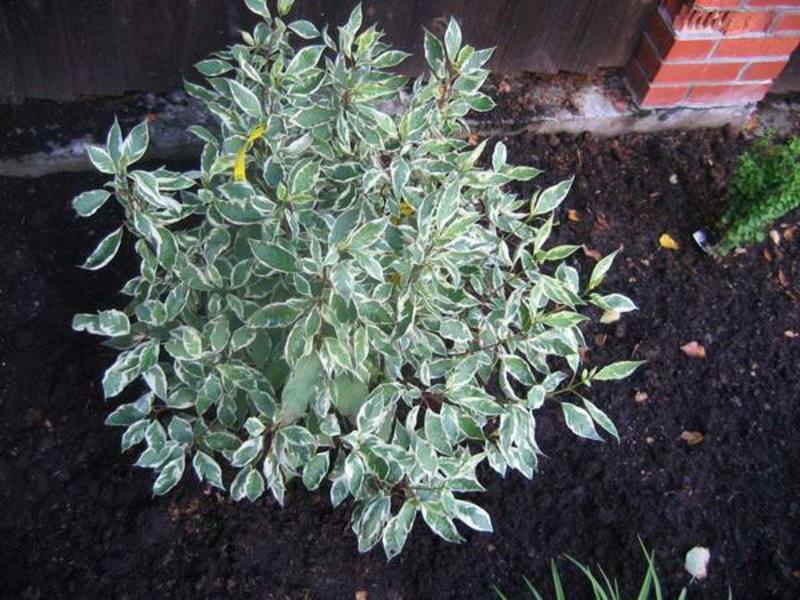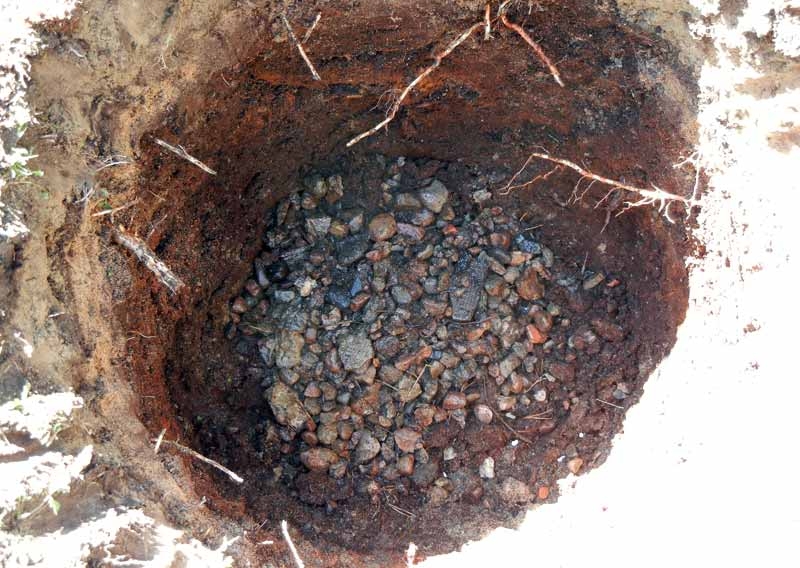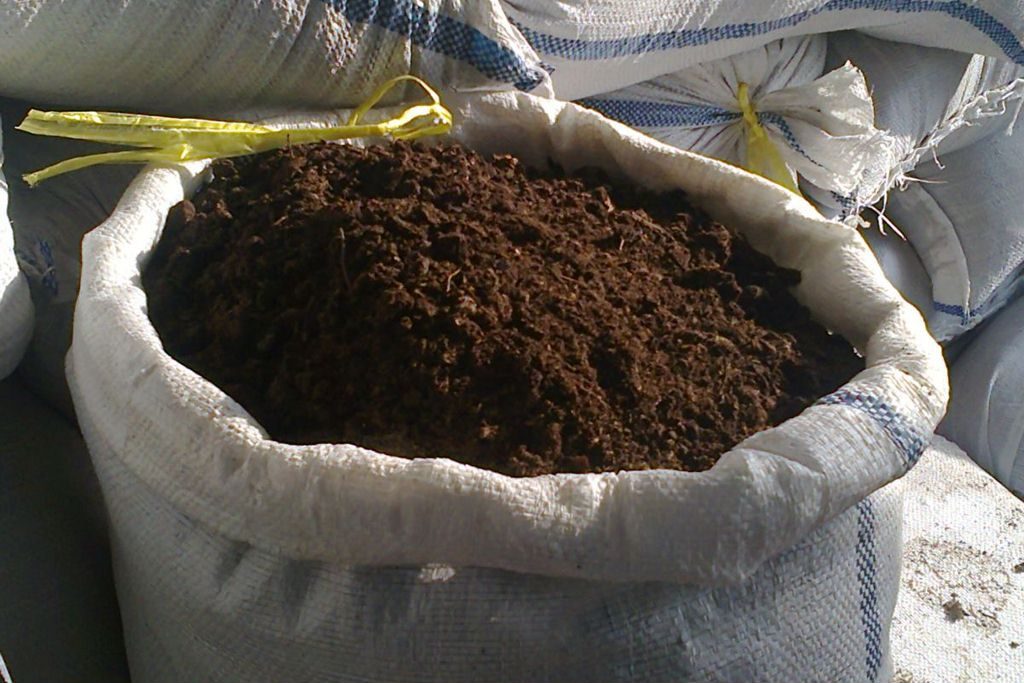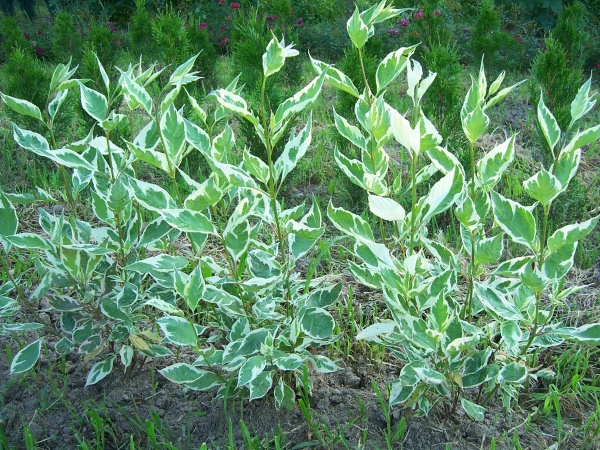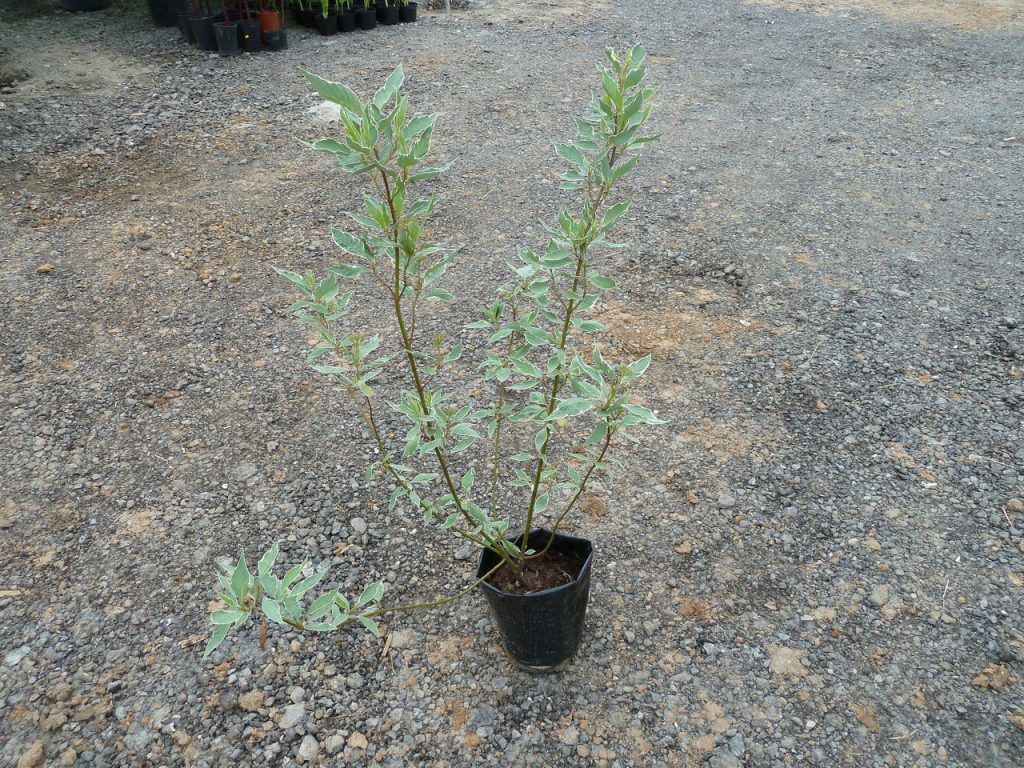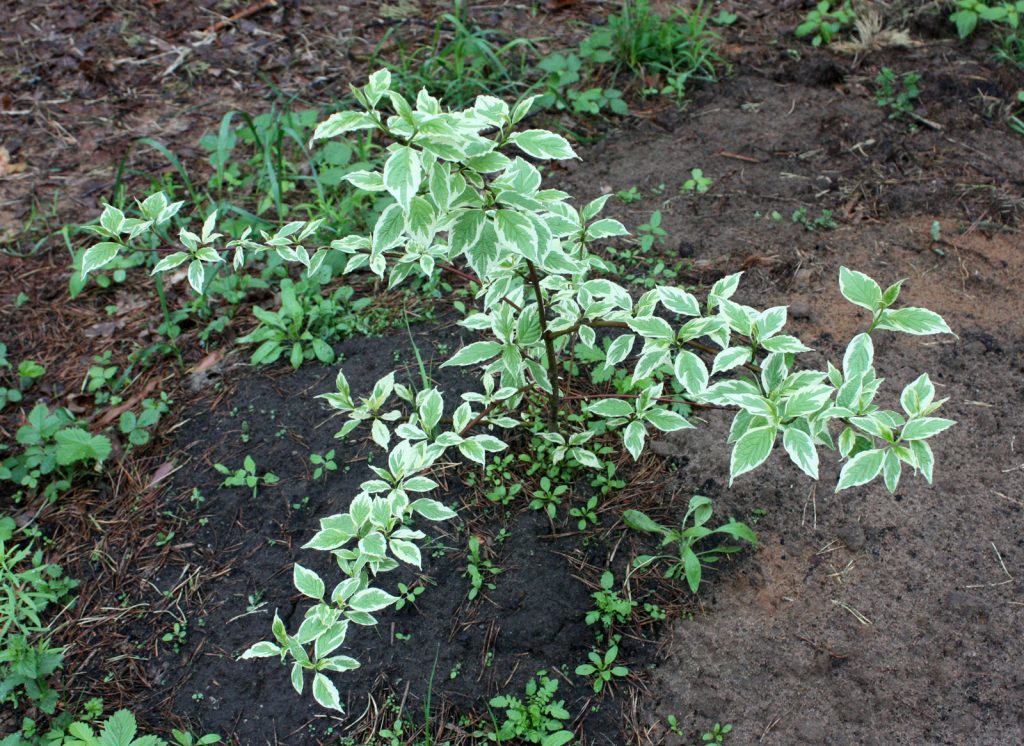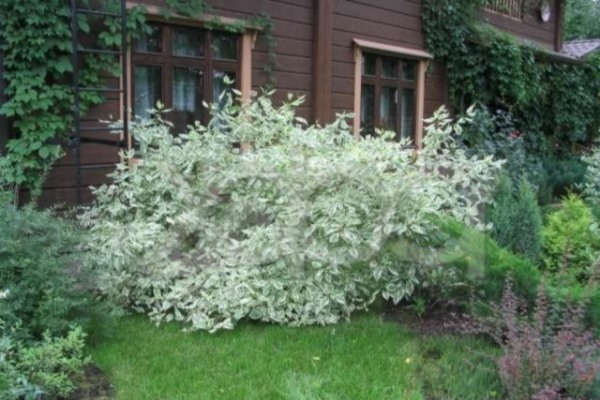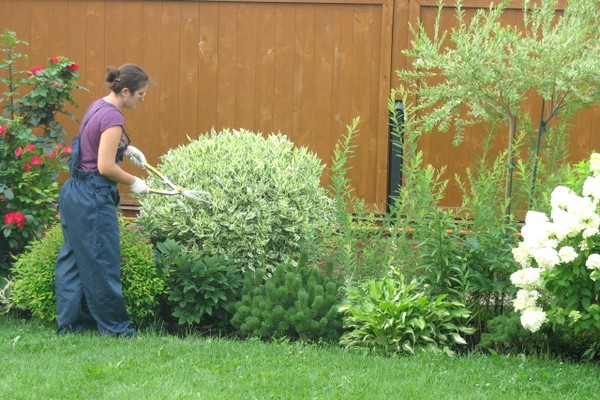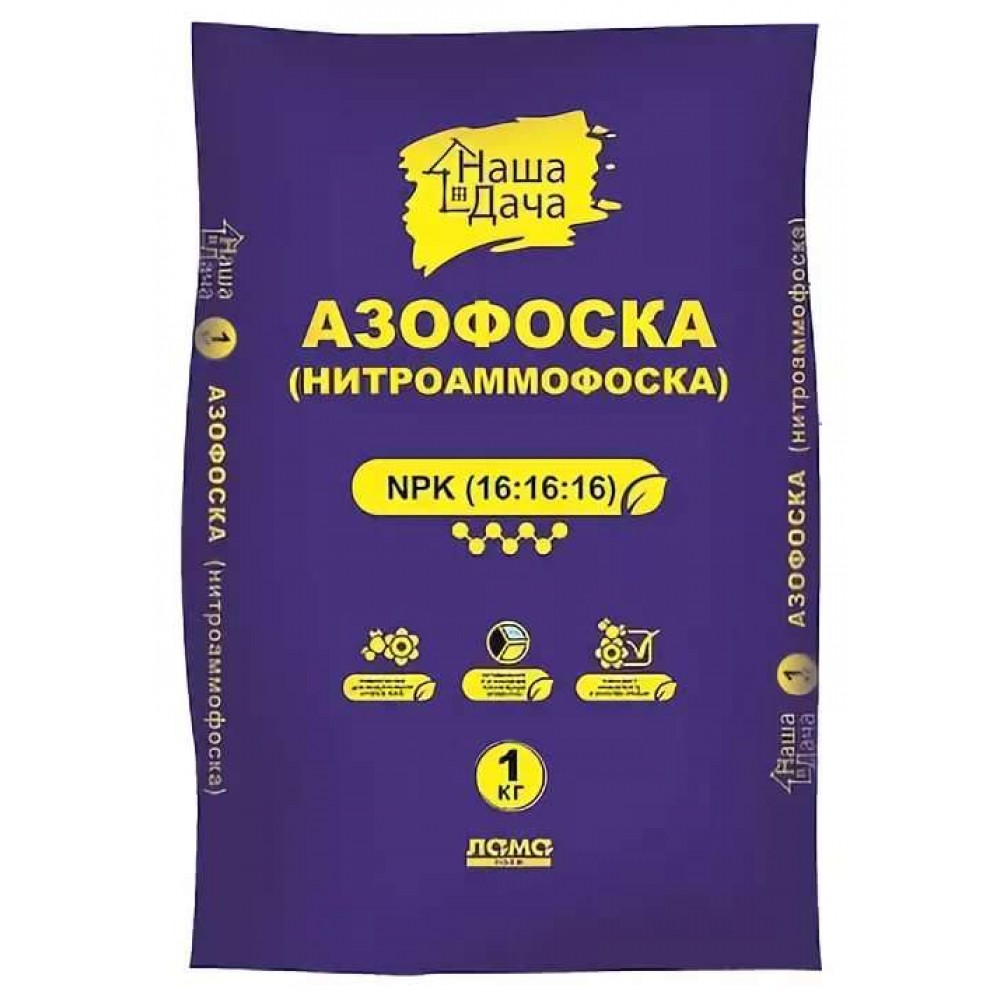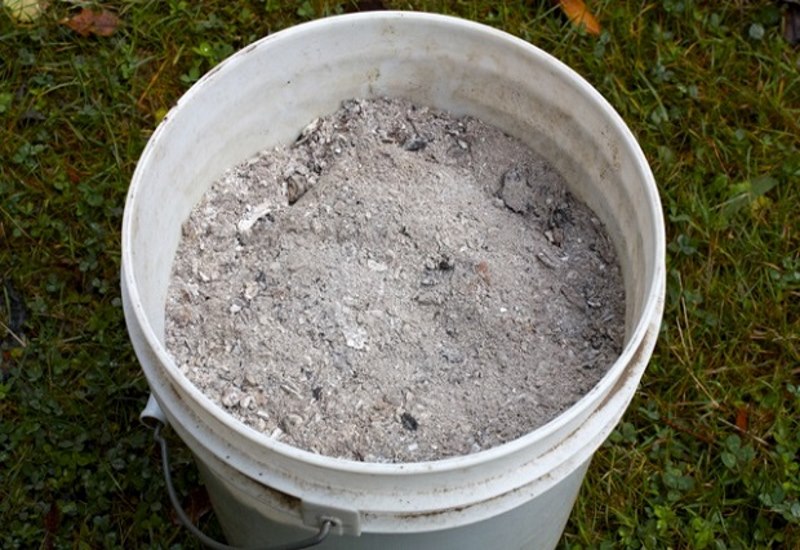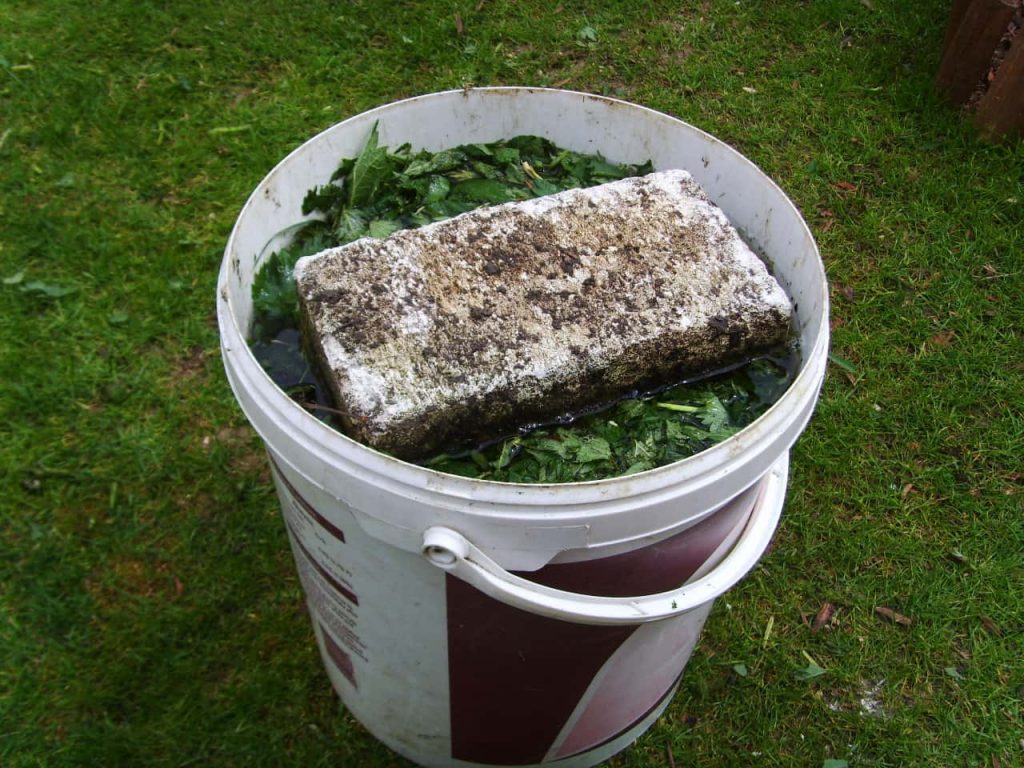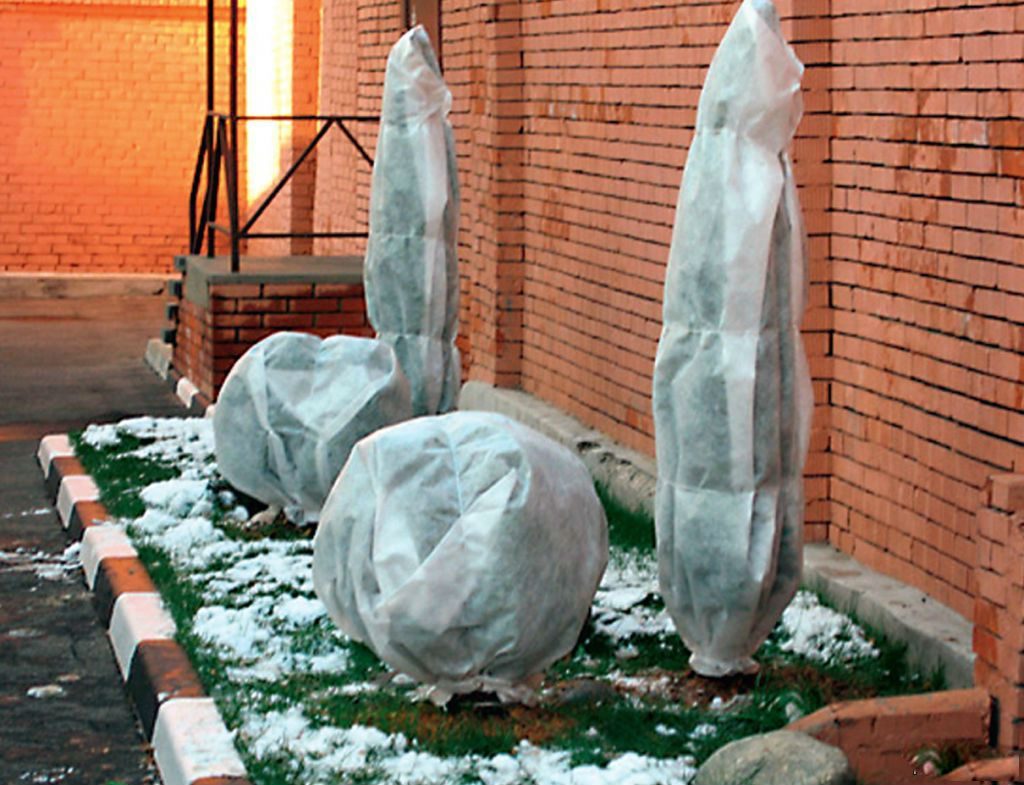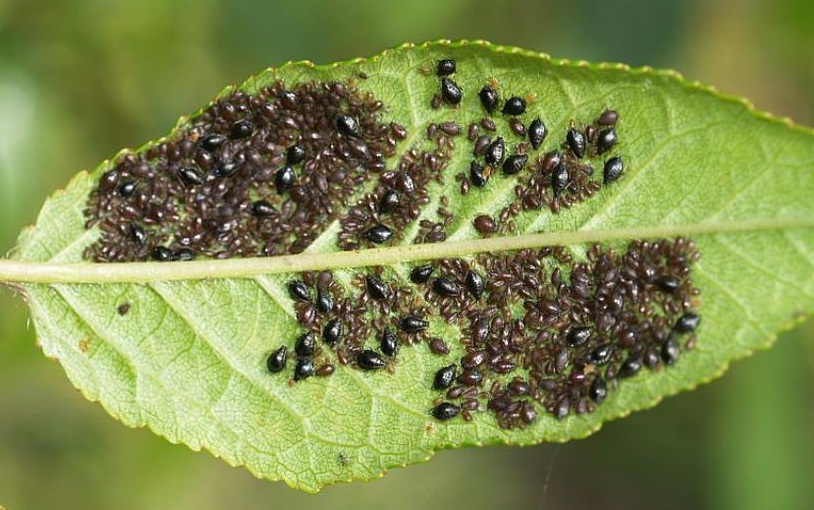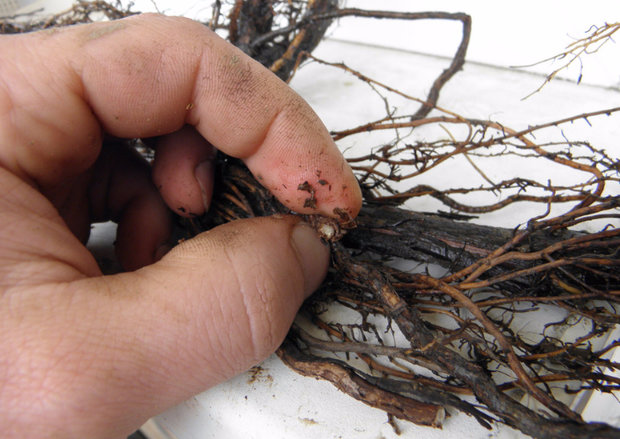Dogwood variegated is an ornamental plant that is rapidly gaining popularity among gardeners. It is extremely unpretentious, while it looks very impressive. The culture is widely used in landscape design. In fact, here the gardener is limited only by his own imagination. The plant looks attractive at any time of the year, even having lost its foliage in winter. The frost resistance of the culture allows it to be planted in most of the territory of Russia, including in regions with a harsh continental climate, and planting and care does not take much time.
Content
Description of variegated turf
This plant is an achievement of breeders. Such a plant does not exist in nature. It was bred on the basis of White Derain from the Cornel family. This plant has solid green leaves. Breeders have added colors - now they have an uneven border of white, cream, yellow, lime, golden hue. Leaves are cordate, with a smooth edge and a well-defined central vein.
The name comes from the Greek "horn". It is due to the fact that turf has very strong and heavy wood. The homeland of the "original" is northern China, the Korean Peninsula, Japan. The plant is also found in the Far East. The optimum temperature for its growth and development is 17–20 ° С.
It is a small tree or shrub, reaching 2.5–3 m in height. The diameter of the crown is 4–5 m. The bark is painted in an unusually bright coral or brick color, glossy shines in the sun. Therefore, the plant does not lose its attractiveness, even after losing its foliage. Its branches look very impressive in winter against the background of white snowdrifts.
The culture blooms and bears fruit twice a season. The first time the buds open in May or June, the berries appear in about a month and a half. The second wave of flowering is the second half of August or September. The berries then look very beautiful against the background of red-orange and purple foliage. The flowers are snow-white, collected in corymbose inflorescences 4–5 cm in diameter, the fruits are bluish-white or greenish, inedible.
Video: what does variegated dogwood look like
The variegated dogwood is distinguished by its growth rate, without much damage to itself it tolerates pruning, even radical. The more often the procedure is performed, the thicker the shrub becomes. This feature makes it suitable for the formation of hedges. Pruning for a plant is a strictly mandatory procedure. The shrub growing uncontrollably in different directions looks very untidy.
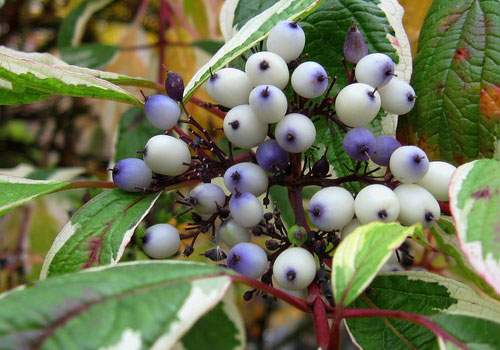
Berries of variegated turf in autumn look very impressive against the background of leaves painted in all shades of red
The undemanding culture of care is simply amazing. Dogwood variegated adapts to almost any climatic conditions, undemanding to the quality of the soil, lighting. Frost resistance allows it to be planted practically throughout Russia, including the Urals, Siberia, where severe winters are not uncommon. The shrub tolerates frosts down to -40 ° C without any problems.
Dogwood is widely used in landscape design. The unpretentiousness of the plant allows it to be planted in city parks, where environmental conditions, as a rule, are far from ideal. It is also appreciated by amateur gardeners. The variegated turf bush can be placed almost anywhere in the personal plot, even where other decorative crops simply do not survive.
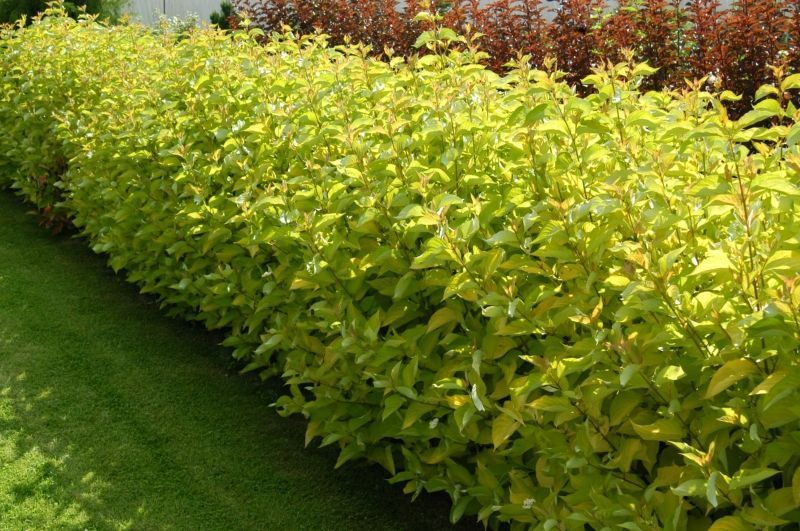
A hedge made of variegated turf turns out to be quite dense, can be used to protect other plantings from the wind
The simplest application you can find for dogwood is to form a hedge, even or stepped. But there are other options for its use. In fact, here the gardener is limited only by his own imagination. Varieties with green-white leaves "dilute" the plantings of a rich dark green color, for example, conifers, adding a refreshing note to the composition, as if "a ray of light".
Sprawling dense shrub covers unsightly walls, fences, and other structures well.
You can plant dogwood in front of larger trees with a high crown and a "bare" trunk. This is the so-called backing. The whole composition visually "deepens", becomes more voluminous, looks more harmonious. Dogwood is good in single plantings, but in combination with other plants it looks even more spectacular. If you plant roses, juniper, barberry, viburnum Buldenezh to it, you get a very bright composition that invariably pleases the eye.
The plant is not only decorative, but also useful. The variegated turf has a powerful root system. It is planted in areas that are characterized by soil erosion, landslides. The area blown by the wind can be surrounded by a "green ring". The density of the variegated turf bushes will protect the plantings located inside from cold drafts.
Video: the place of a plant in landscape design
The most common varieties with photos
This is not to say that there are many varieties of variegated turf, but among the available, every gardener will surely find a variety to his liking. All of them are unpretentious in care and very effective.
- Elegantissima. One of the most common varieties in garden plots. Well suited for single landings. The height of the shrub is 2.5 m. The shoots are straight, bright, coral in color. Leaves with a pointed tip are slightly concave along the central vein. The main color is green with a bluish tint, the border is white or pale salad, rather narrow. The flowers are white or pastel pink.
- Sibirica Variegata. The height of a very dense shrub is 1.2–1.5 m. Bright, almost blood-scarlet branches. The leaves are flat, elongated, salad green. The edging is snow-white. In the fall, they change their hue to a rich purple with a purple tint. The flowers are greenish cream. The berries are blue-blue, covered with a thick layer of "wax" bloom.
- Gouchaultii. A very "massive" squat bush. Its height is only 1.5 m. The shoots are dark scarlet, long, flexible, dull. On the leaves, a wide, uneven border of lemon-yellow color. If the plant is planted in open, sunny areas, it begins to cast pinkish. The flowers are straw yellow, the fruits are bluish.
- Cream Cracker. A very graceful shrub with a crown directed upwards. From it, you can easily form a standard tree. The border on the leaves is light beige or cream. In autumn, it changes its shade to lime.
- Spaethii. Bred over a century ago. A variety of variegated turf with a bright golden-yellow border on the leaves. Sometimes it can cover most of the leaf plate. Those that are just blooming are orange-red. In autumn, they are painted in different shades of purple, aloe-lilac, almost purple. Plant height - up to 3 m, spreading crown, wide. Flowers are yellowish, a shade of butter. It tolerates heat, drought, frost perfectly. It stands out for its growth rate, adding 20 cm each year.
- Argenteomarginata. The height of the shrub is about 3 m, the crown is spreading. Shoots without pruning slightly nod. The leaves are elongated, up to 10 cm long. The main tone is grayish green with a silvery sheen, the border is creamy white. Spots and streaks of the same color may be present. In autumn, the color of the leaves varies from golden lemon to brick red. The flowers are yellowish-white, the berries are of the same shade, with a bluish tint. The variegated color is not lost in the shade, but disappears under the bright sun.
- Ivory Halo. One of the novelties of selection. The height of the shrub is up to 1.5 m. The crown, even without pruning, takes the form of an almost regular ball. The leaves are light green, the border is ivory, as if pearlescent. The bark on young shoots is bright red, then gradually changes color to brick.
- Kernii. Grows up to 2 m in height. Leaves with a border and lemon-yellow spots of various sizes. The bark on young shoots is colored in an unusual reddish-burgundy color.
- Westonbirt. The height of the shrub is about 1.5 m. The bark on young shoots is coral pink, then gradually darkens. The leaves are also pink.
- Behnschii. It grows up to 1.5–2 m in height. Young shoots are bright scarlet. The leaves are dotted with small white, cream and sometimes dull red specks. There is a narrow border along the edge.
- Aurea. A very striking contrast between lemon yellow foliage and bright red branches. The shrub is quite compact, up to 2 m in height, the crown is spherical.
- Aurea Elegantissima. The bush grows up to 2 m. Young leaves of a brick shade, then turn yellow. They are wider than other varieties, almost round, matte. In autumn, they acquire a slight reddish tint, but the general tone does not change. When grown in the sun, a beige-brown streak may appear at the edge of the leaf. Compared to other varieties, it demonstrates less frost resistance.
Photo gallery: varieties popular with gardeners
- Dogorain Elegantissima is one of the most popular varieties of culture
- Dogwood Sibirica Variegata - very dense, low shrub
- On the Gouchaultii turf, the leaves take on a pinkish tint in direct sunlight.
- Dogwood Cream Cracker is suitable for forming a standard tree
- Dogwood Spaethii is a very showy plant species
- Dogwood Argenteomarginata may lose its characteristic coloration in the sun
- Dogwood Ivory Halo - one of the latest achievements of breeders
- Dogwood Kernii has an unusual bark shade
- Dogwood Westonbirt is easily recognizable by the color of its leaves
- The Behnschii turf has leaves with a rather narrow border.
- Dogwood Aurea is a suitable plant for those who do not have enough autumn even in summer
- Dogwood Aurea Elegantissima slightly differs from its "relatives" in the shape of the leaves
Planting procedure and preparation for it
Unpretentiousness extends to the conditions of planting and caring for variegated dogwood. The plant tolerates almost any quality substrate, including saline, acidic, and alkaline. The only thing that categorically does not suit him is groundwater, located closer than one and a half meters from the soil surface. This can provoke the development of root rot. For the same reason, it is undesirable to plant dogwood in a clay, peat, or silty substrate that sour easily. The ideal option for a shrub is a fertile soil that allows water and air to pass through well.
The plant feels good both in the shade, and in partial shade, and in the bright sun. This does not affect its development. But over time, especially in the absence of proper care, the variegation of the leaves can fade to uniformity both in direct sunlight and with a lack of light.
The root system of variegated turf is quite powerful and developed. Therefore, it is advisable to place the shrub away from plants with superficial, fibrous roots. He can simply "strangle" them or deprive them of nutrition, drawing water from the soil, the necessary macro - and micronutrients.
The planting procedure is most often planned for the spring. In regions with a temperate climate, this is generally the only possible option. Only in this case can it be guaranteed that the plant adapts to new habitat conditions before the first frosts and forms a sufficiently developed root system that will provide it with everything necessary for wintering.
The culture is deservedly considered frost-resistant, but with planting it is recommended to wait until the air warms up to 12-15 ° C, and the soil - up to 8-10 ° C at a depth of 10-12 cm. The specific disembarkation time depends on the climate in the region. It can be mid-April or late May. You can focus on folk signs - birch leaves that have begun to bloom, dandelions in bloom.
The planting pit is prepared in advance, at least two to three weeks before the procedure. And it's better to dig it out in the fall, adding all the necessary fertilizers. Its optimum depth is 55–60 cm, and its diameter is about half a meter. If the quality of the substrate is such that moisture will clearly stagnate in it, a bucket (or a little more) of expanded clay, pebbles, crushed stone, small ceramic shards, brick chips is poured onto the bottom. This will be the drainage. It is necessary to form a layer at least 4–5 cm thick.
Rotted compost or humus must be added - about 10 kg per pit. It must be mixed with the top layer (10-15 cm) of fertile soil extracted from it. With gratitude, the variegated dogwood will also accept mineral fertilizing - 50–70 g of simple superphosphate, 25–30 g of potassium sulfate and 40–50 g of carbamide are enough. Those who prefer to do without chemicals can replace them with sifted wood ash. A liter can is enough.
The finished planting pit is covered with any material that does not allow water to pass through so that the nutrient mixture at the bottom does not wash out. For example, a piece of slate, roofing material is suitable.
If you plan to plant several single specimens, the minimum distance between the planting pits is 1.7–2 m. When forming a hedge, the interval between adjacent bushes is reduced by 2–2.5 times.
For planting, plants up to four years old are chosen. Adult specimens take root much worse. They are purchased (however, like any seedlings) only from reliable, trustworthy suppliers with a good reputation. Shopping at markets, fairs, just off hand is a big risk. A gardener, especially an inexperienced one, can sell anything under the guise of the desired culture. It is desirable that the nursery where the seedlings are grown is located in the same area or nearby. Plants from it are already familiar with the peculiarities of the local climate, this contributes to the fastest adaptation to a new place.
When choosing a seedling, be sure to pay attention to the root system. It should be developed, the length of the taproot should be at least 20 cm. Dried and rotten roots are absent in healthy plants. They should be pliable, creamy white or pale green when cut. The bark of such specimens is smooth, elastic, uniform, without spots suspiciously resembling mold or rot.
There is nothing complicated about planting a plant in the ground. Even a novice gardener can handle this. It differs little from a similar procedure for other fruit trees and berry bushes.
- In seedlings with an open root system, the roots are soaked for 2-3 hours in water at room temperature.Potted specimens should be watered abundantly about half an hour before planting. In the first case, a little potassium permanganate is added to the water (to prevent fungal diseases) and / or any biostimulant (to strengthen immunity and enhance growth). Then the roots are coated with gruel from powdered clay diluted with water and fresh cow dung. In consistency, this mass should resemble thick sour cream. She is allowed to dry out in the open air. A couple of hours is enough.
- The nutrient mixture at the bottom of the pit is moderately watered and loosened, forming a kind of mound from it. If a single planting is planned, for the first time you will need a support - a peg 25-30 cm higher than the seedling, taking into account the depth of the pit. It is stuck into the soil at the bottom, slightly receding from the center of the mound.
- The seedling is placed at the bottom of the pit so that its roots are directed downward, rather than sticking up and to the sides. Then it is covered with small portions of soil, periodically shaking the plant slightly to fill the resulting "air pockets". The position of the seedling should be such that when the hole is completely filled up, the root collar is 2-3 cm above the ground surface. If you deepen it, the plant will die. And when it is located too high, instead of healthy lateral shoots, weak "offspring" are formed.
- After planting, the soil in the trunk circle is well moistened, consuming 20–25 liters of water warmed to room temperature. When the moisture is absorbed, it is gently shallowly loosened and mulched.
Video about planting and further work with the culture
Young specimens of variegated turf tolerate adaptation to new habitats and the associated stress is quite easy. But for mature plants, the process is rather difficult. A transplant is carried out only when it cannot be done without it. For example, if a place for a bush is chosen extremely poorly, it oppresses other plantings, the leaves have lost the variegated color inherent in the variety. In addition, it is difficult to extract an adult plant from the ground due to the developed root system.
The procedure is carried out in late autumn, when the dogwood has completely shed its foliage, or in early spring, when the growth buds are not yet "awakened" and not swollen. The plant is removed from the ground along with a clod of earth on the roots, trying to damage it as little as possible. The diameter of the root system approximately coincides with the crown of the bush. The earthen lump must be carefully wrapped in plastic or burlap, transferred to a new place. After transplanting dogwoods, they must be watered abundantly, the soil is mulched with humus mixed with peat chips.
Instead of purchasing planting material, you can get it yourself if there are already specimens of variegated turf on the site. The plant reproduces well both vegetatively (cuttings, dividing a bush, rooting of cuttings) and generative (germinating seeds) in a way. The latter breeding method is the most time consuming and time consuming. In addition, it is impossible to guarantee that the main varietal trait will remain - the motley color of the leaves.
Important nuances of caring for variegated dogwood
Dogwood variegated - a plant from the "planted and forgotten" category. Many gardeners do just that. But in order for the shrub to retain its decorative effect and develop normally, a minimum of time and effort will still have to be spent on it.
The main thing a plant needs is regular pruning. Specimens with thickened, "bald" branches sticking out in different directions look very unpresentable. The dogwood procedure tolerates well, even if the gardener overdoes it slightly. During the active growing season, depending on the growing conditions of dogwood, it adds 30–100% of the green mass.
The first pruning is carried out at the beginning of the third season after planting in open ground.No more than a third of all shoots are removed, leaving the most powerful and developed ones.
The procedure is carried out in early spring, before the start of active sap flow, but always at above-zero temperatures. An exception is hedges, which are formed twice a year, in July and September. For this they use extremely clean, sharply sharpened and disinfected tools - knives, scissors, secateurs. All "wounds" must be thoroughly covered with garden varnish, after washing with 2% copper sulfate or a bright pink solution of potassium permanganate with the addition of crushed chalk and any fungicide.
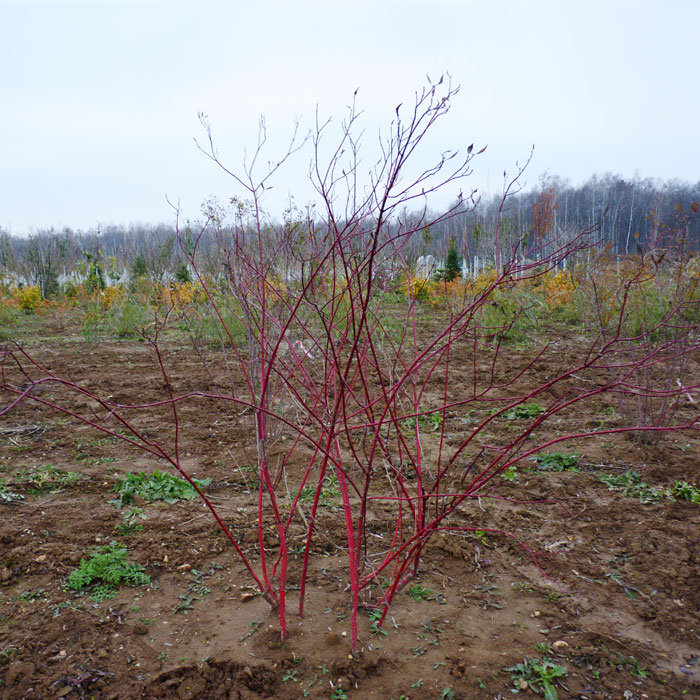
Turf pruning is carried out when the plant has completely lost its foliage in autumn or has not yet "woken up" in spring
As for the configuration, here the gardener is limited exclusively by his own imagination. A variegated turf bush can be given any, the most incredible outlines. Not least for this it is appreciated by landscape designers. Although many people prefer to just slightly correct the natural shape.
Be sure to get rid of broken, leafless, dried, deformed, twisted shoots. Those that grow inward, thickening the crown, or downward also look bad.
Variegated dogwood belongs to the category of plants - "chimeras". Their tissue cells have differences at the genetic level. Therefore, sometimes a gardener can find monochromatic green leaves on shrubs with an initially variegated color. Together with the shoots, they must be removed in a timely manner, because they are genetically stronger. If you do not prune in time, the variegation will soon disappear altogether.
Video: trimming the turf
Young plants and transplanted adult specimens need daily moderate watering during the first week after the procedure. In general, variegated dogwood tolerates drought and heat without much damage to itself. Powerful roots draw moisture out of deep soil layers. Adult plants are watered at the root once a month. If there is a strong heat for a long time, and there is no precipitation, the intervals between procedures are reduced to 5–8 days. Water consumption rate - 20-25 liters. By autumn, watering is gradually reduced.
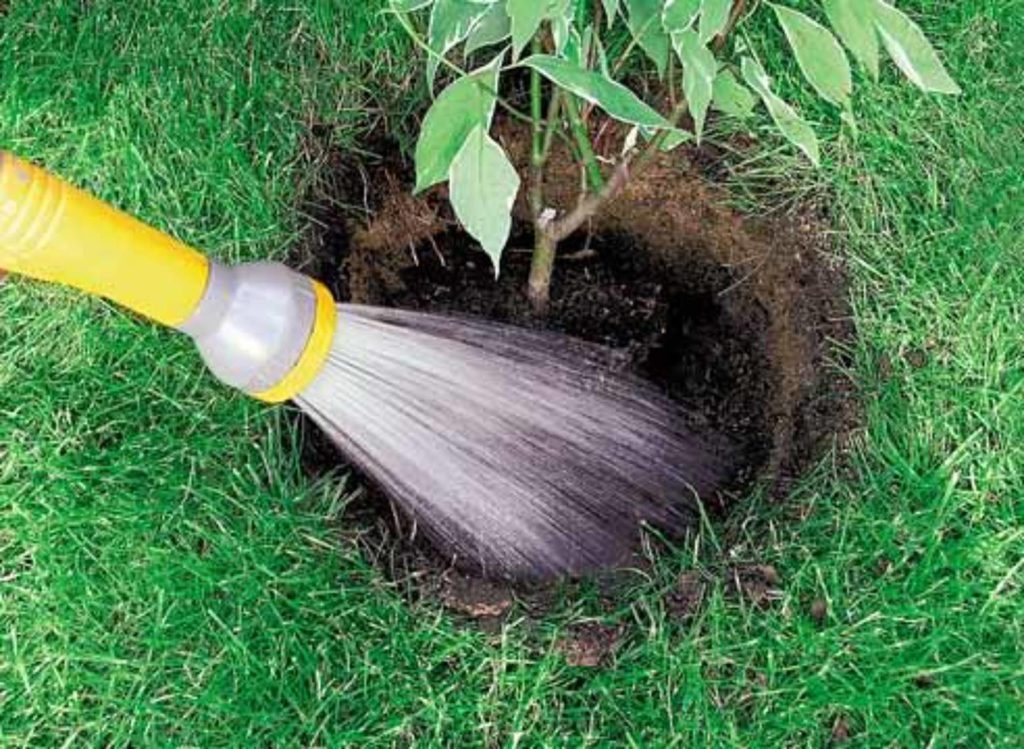
The variegated turf bush does not need frequent watering, the root system may well provide the plant with everything it needs, including moisture
Top dressing is applied twice during the growing season, in spring and autumn. In the first case, a complex mineral fertilizer with a content of nitrogen, phosphorus and potassium (Azofosk, Diammofosk, Nitrofosk) is used. For an adult plant, 200 g is enough. Once every 3-4 years, you can pour a bucket of humus or rotted compost under the bush, mixing it with the soil in the process of loosening.
In the fall, the tree needs phosphorus and potassium. The natural source of these macronutrients is wood ash. It is poured dry to the roots if it is rainy. When there is no precipitation for a long time, an infusion is prepared - a half-liter can of raw materials for 3 liters of boiling water. You can also use complex fertilizers without nitrogen, for example, ABA, Autumn.
During the active growing season, if desired, about once a month, you can feed variegated turf bushes with natural organic matter. Infusions of fresh cow dung, chicken droppings, nettle greens, dandelion leaves are suitable for this. In general, any weeds growing in the garden can be used as raw materials. They are crushed, filled in about a third of the deep container. The remains are topped up with water. The container is tightly closed, and left in direct sunlight for several days. The fact that the fertilizer is ready is signaled by the characteristic "aroma". Before use, it is filtered and diluted with water in a ratio of 1: 8. If the product was based on droppings, it will need twice as much.
To increase the growth rate, it is useful to feed young (1–2 years old) plants with store-bought complex mineral fertilizers, alternating root and foliar feeding. The solution is prepared according to the manufacturer's instructions given in the instructions.
Only young variegated turf plants under the age of five years need special preparation for winter. Adult specimens tolerate even severe Ural and Siberian frosts without much damage to themselves.
The soil in the near-trunk circle is cleared of plant debris, loosened. The mulch layer is renewed. It is advisable to use humus or peat chips. At the roots, its thickness is 10–15 cm, on the rest of the area, 5–6 cm is enough. If the size of the shrub allows, it is covered with a cardboard box of a suitable size. Shoots can be gently lifted and tied up from below for more compactness. The box is stuffed with straw, fallen leaves, wood chips, crumpled newsprint.
Another option is to build a structure like a hut. Poles of suitable height are used as a frame. Several layers of burlap or other air-permeable covering material (agril, lutrasil, spunbond) are pulled over them.
Video: the experience of growing variegated turf
Possible growing problems
Variegated dogwood is an extremely problem-free plant. To ruin it, you need to try very hard. It practically does not suffer from pathogenic fungi. The only exception is root rot, the development of which is most often provoked by the gardener himself, who too often and / or watered the plantings abundantly. Pests on the shrub also do not pay special attention. Only aphids can cause significant harm to him.
Another possible problem is that the leaves lose their tone, numb. This is due to a lack of moisture in the soil and most often occurs during prolonged heat and drought. It is enough to water the plant abundantly several times, and its condition will return to normal.
Aphids effectively repel any infusions with a pungent odor. It is enough to process the bushes twice a month. As raw materials, you can use any spicy herbs, wormwood, yarrow, tomato and potato tops, marigolds, onion and garlic arrows.
If pests are found, the turf bush is sprayed with soapy foam, after about half an hour it is washed off with water from a hose. If the desired effect is absent, the same infusions are used, but the interval between treatments is reduced to 6–8 hours. Other effective means are baking soda or soda ash diluted with water, mustard powder. In the event of a mass invasion of a pest, any general action insecticides are used.
Root rot is dangerous because the pathogenic fungus develops for a long time without manifesting itself in any way. When the first symptoms are noticeable on the aerial part of the bush, it is usually too late to save the plant. The bases of the shoots soften, turn black, become slimy to the touch, and can become covered with a layer of mold. They give off an unpleasant putrid smell. The leaves lose their tone, sag, dark spots blur on them.
To prevent the development of rot, potassium permanganate is periodically added to the water for irrigation to a pale pink color. Crushed chalk or wood ash is added to the roots. Having found characteristic signs, watering is reduced to the required minimum, all affected shoots are cut off. Granules of Trichodermin, Glyokladin are added to the soil. The plant itself is sprayed 3-4 times with a solution of any fungicide. But these measures may not work. Then the turf bush can only be dug up and burned. For disinfection, the soil in this place is spilled with a 5% solution of potassium permanganate or Bordeaux liquid. Layers and cuttings can be taken from the affected plant, but only from healthy shoots.
Gardeners reviews
The bush of variegated turf is rather thick and spreading, so that the neighbors will not shine through. I have white dogwood sitting along the fence, very happy. There are variegated varieties, with a white border and a yellow border, growing in the sun. Even now, without foliage, they are quite thick.
My dogwood grows in the country. I'm happy with it. Decorative, growing quickly, unpretentious to soil conditions. It blooms twice a season - the first time in spring, then beautiful berries appear, they crumble and dogwood blooms again. The second wave of berries falls in autumn and looks great against the background of crimson foliage.
Dogwood grows well in partial shade and almost in the shade. Looks much better than in the sun. At least that's the case for me.
My dogwood (Cornus alba Sibirika) - young leaves of bright salad color, then darken a little. If there is a temperature drop, it gets colder, the leaves begin to turn red. Last year, it even bloomed twice for me, as it was warm - in May and August, and in June-July it was cold and the leaves turned very red ... After the cold June-July, hot August came and dogwood bloomed again - probably, I decided that spring has come again. I think that all this is quite normal for a plant. And the coral-red branches against the background of the light wall of the house in winter delight me.
I like dogwood variegated! I bought it two years ago, did not regret it Unpretentious at all, has grown well. In the fall I even outlined it, not all the cuttings, but they began.
Dogwood grows quickly, it is really beautiful and tolerates winters near Moscow. In general, we are happy.
You cannot imagine a more unpretentious plant than variegated dogwood. It is very winter-hardy - it does not freeze even at -40 ° C. If you need a colorful background, it will be very suitable, but I like it in winter - bright red branches against a background of white snow. The beauty!
If Shpeta dogwood comes across, I advise you to buy it. Very beautiful foliage. The same unpretentious and rapidly growing, like other varieties.
Dogwood variegated unpretentious, undemanding to soil. It grows in the most problematic areas. If not shaped, it grows up to 3 m.Hairstyle tolerates well. I also recommend Shpet - very beautiful foliage of yellow-green-orange shades.
It is difficult to find a shrub more unpretentious than turf. It grows in any place, it winters well in the Moscow region. He loves a haircut very much: the more you cut, the more it grows. I have two different variegated - with white and yellow variegation.
Dogwood variegated is prized by gardeners for its ease of growing and attractive appearance. It can be placed where conditions for other ornamental crops are unacceptable. Also, the shrub is distinguished by its growth rate, easily tolerates pruning, and rarely suffers from diseases and pests. Even a novice gardener can grow it. Bright variegated leaves and unusual bark color will invariably delight the eye.
